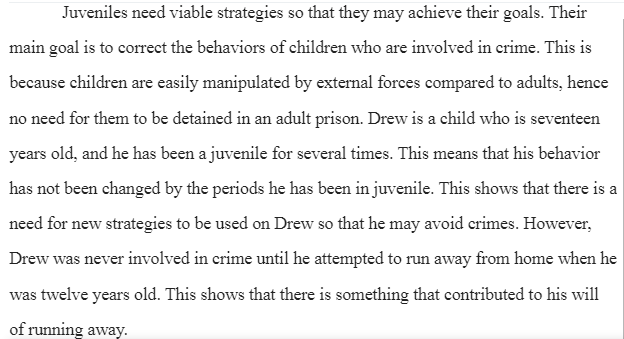Juvenile Reentry Plan
Here’s What Happened . . .
Juvenile reentry is defined as programs, services, and supports intended to assist youths transitioning from (juvenile corrections) residential placement back into the community (Gies, 2003). Reentry represents a small but crucial part of the corrections continuum as the proper coordination of substance abuse, mental health, educational, vocational, and other services is critical if the youth in question is to successfully rejoin the community. In this exercise, you will consider a wide assortment of contributing factors in one juvenile’s situation and will select the most salient points to determine how best to successfully reintegrate this juvenile into the community.
Scenario
You are a reentry specialist at the Centervale Juvenile Detention Center. John Drew is a seventeen-year-old male who has been detained in the facility for the previous nine months. His first offense on record was running away from home when he was twelve. Since then, he has appeared in juvenile court for a number of offenses, including trespassing, breaking curfew, shoplifting, and possessing prescription drugs illegally. His most recent offense, and the one responsible for his stay in the Centervale Juvenile Detention Center, was an unarmed assault on another youth. Drew is quite behind in his studies, having completed course work only through his eighth-grade year.
During his time at the detention center, Drew was given a mental health assessment and found to have bipolar disorder. He has a history of substance use, using marijuana, methamphetamine, and cocaine; Drew recently indicated that he now prefers prescription drugs. Upon release, Drew will serve two years on probation. Drew’s parents have stated that he will live in their home upon release, though he has in the past stated his intentions to live on his own. He has expressed remorse for his previous behaviors and says he’s anxious to get a fresh start.
Here’s What You Need to Do . . .
For this assignment, you have been directed by your supervisor to write a reentry plan based on the scenario above. Specifically, you’ve been instructed to develop a reentry plan for Drew that includes the following:
- The context for Drew’s reentry plan. Offer an examination of the history of juvenile treatment. How did the notion of juvenile treatment begin, and how has it changed since? Describe some of the major trends in juvenile corrections and explain the effect of each. Examine and describe the current state of juvenile treatment.
- An assessment of Drew’s current state, including a review and summary of Drew’s scenario given above. Given that you have limited information from which to draw conclusions, make assumptions based on your knowledge of juvenile treatment issues where data for Drew is missing or incomplete. Be sure to clearly note when you make an assumption and give clear, well-reasoned examples as support. Also, make sure to draw from research, including digital assets and resources suggested by this course, when appropriate.
- An analysis of your initial assessment. What are the most important factors affecting Drew’s successful integration into the community? How might Drew’s co-occurring disorders or issues play into one another? What other factors might affect Drew’s return to the community? Explain your answer using examples and reasoning.
- A comprehensive reentry plan based on your assessment and analysis of Drew’s case and your examination of the history of juvenile treatment. What recommendations do you make for Drew’s case? How do elements of Drew’s plan fit into the continuum of juvenile corrections? Which approaches, if any, should be avoided for Drew and why? What sorts of actions and behaviors do you want to minimize or emphasize? How will you maintain Drew’s accountability? What other resources might you recommend for Drew?
Click here to download a reentry plan template for use.
Resources:
More information about reentry and reentry plans can be found at
http://policyoptions.pbworks.com/w/page/20267935/Juvenile-Offender-Reentry.
Gies, S. (2003). Aftercare services. Washington, DC: US Department of
Justice, Office of Justice Programs, Office of Juvenile Justice and
Delinquency Prevention.
Submission Details:
- Save the document as M5_A1_Lastname_Firstname.doc.
LASA 2 Grading Criteria and Rubric
All LASAs in this course will be graded using a rubric. This assignment is worth 300 points. Download the rubric and carefully read it to understand the expectations.
Answer Preview-Juvenile Reentry Plan

